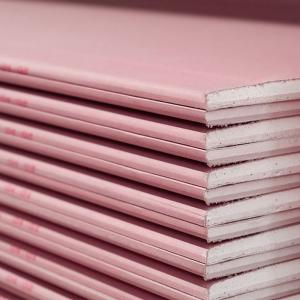

Add to Cart
Plaster Board is often called drywall, wallboard, or plasterboard. It differs from other panel-type building products, such as plywood, hardboard, and fiberboard, because of its noncombustible core and paper facers. When joints and fastener heads are covered with a joint compound system, gypsum wall board creates a continuous surface suitable for most types of interior decoration.
Ordinary gypsum plaster board appearance is ivory-colored surface
with gray back. It is mainly made of construction gypsum with
appropriate amount of lightweight materials, fiber reinforcement
and additives, and glued to paper.
It has the characteristics of light weight and high strength, heat
and sound insulation, etc.
1. Fire resistance
Since gypsum itself is a fire resistant material, gypsum
plasterboard can also be fire resistant for up to four hours. The
reason behind this is the presence of water in gypsum offerings.
When water comes in contact with fire, it starts evaporating. It
helps the board to form a protective layer which helps to prevent
the fire from spreading over a period of time.
2. Non-combustible
When a gypsum board comes in contact with fire, it starts the
process called calcination. Calcination is the process by which the
board dehydrates, helping it to form an additional layer. It makes
the wall non-combustible for several hours and always remains at
room temperature.
3. Acoustic properties
Gypsum board has an inherent degree of acoustic insulation. These
are more effective compared to conventional walls of the same
thickness. This is because they contain sound interruptions and
reduce reverberation.
For example, a plasterboard of around 60 mm is as effective as an 85 mm masonry wall in terms of sound insulation. Users can also choose to use acoustic gypsum board to further improve performance.
4. Thermal performance
Gypsum boards contain water of crystallization. They also contain
cavities that allow the user to achieve the right balance between
humidity and temperature. If you add fiberglass, it will further
prevent fire as the fiberglass helps maintain the integrity of the
board. The additional insulation acts as a vapor barrier and helps
control humidity in the room.
Item | Standard Value | Test Value | ||||
Density (kg/m²) | — | Thickness | Regular | Fire Resistant | Water Resistant | |
≯ 9.5kg/m² | 9.5mm | 7.5 | 7.5 | 7.5 | ||
≯ 12.0kg/m² | 12mm | 9.5 | 9.5 | 11.5 | ||
Flexural Strength(N) | Parallel | ≮ 360 | 9.5mm | 560 | ||
≮ 500 | 12mm | 700 | ||||
Cross | ≮ 140 | 9.5mm | 180 | |||
≮ 160 | 12mm | 240 | ||||
Surface Paper Sticking theCore Material | Unexposed | Unexposed | ||||
Stability with Fire (Min) | Fire Resistant | ≮ 20 | / | / | >20 | / |
Water Absorption (%) | Water Resistant | ≮ 10 | 9.5mm | / | / | 6.8 |
12mm | / | / | 4.2 | |||
Radioactivity | Internal | IRa≤1.0 | <1.0 | |||
External | Ir≤1.3 | <1.0 | ||||
Note | Executive Standard : GB/T 9775-2008 | |||||
Common specifications: 9mm,9.5mm,12mm
Ordinary gypsum board sound insulation wall composed of double-layer separation type and hollow strip board has the same effect asthe brick wall of 24cm
Ordinary gypsum board has a wide range of applications
Used for hotel, restaurant, shopping mall, office, theater, studio, cinema and school and other buildings partition wall application, ceiling application.
